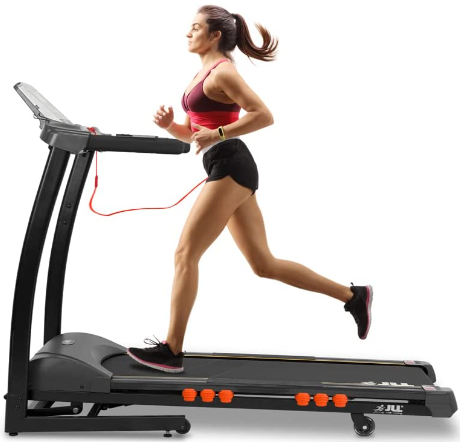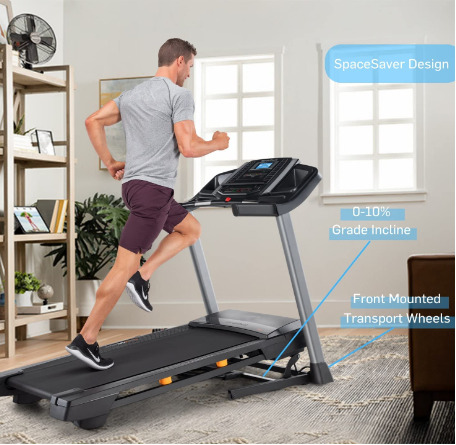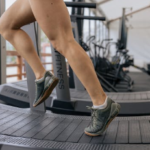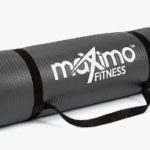A treadmill is a popular exercise machine that allows individuals to walk, jog, or run indoors. It consists of a moving belt that is powered by a motor, which simulates the experience of walking or running on a flat surface. Treadmills come in a variety of models with different features, making them a versatile option for individuals looking to improve their fitness levels.
Convenience
Treadmills have been a popular exercise machine for many years due to their ease of use and convenience. They are ideal for people who don't have access to outdoor running areas, such as those who live in cities or areas with inclement weather conditions. Treadmills can be used in the comfort of one's home or at a gym.
View also: Great Value Treadmills here
Low Impact Workout
One of the biggest advantages of treadmills is that they provide a low-impact workout that is easier on the joints than running on concrete or asphalt. This makes treadmills an ideal option for individuals with joint problems, arthritis, or other conditions that make high-impact exercise painful. Additionally, treadmills provide a controlled environment where individuals can monitor their speed, distance, and other metrics to track their progress over time.
Incline Settings
Treadmills also offer a range of features that can make workouts more enjoyable and challenging. For example, some treadmills come with incline settings that simulate uphill running, which can increase the intensity of the workout. Other treadmills have built-in workout programs that vary the speed and incline, keeping the workout challenging and interesting.
Disadvantages
However, there are some disadvantages to using treadmills. One of the main drawbacks is that they can be expensive, especially for high-end models with advanced features. Additionally, some people find running on a treadmill to be boring compared to running outdoors. Finally, treadmills require regular maintenance and can take up a significant amount of space in the home.
Check out: JLL Foldable Treadmill @ Amazon here
Maintenance
Treadmills are a popular exercise machine that offers many benefits to individuals looking to improve their fitness levels. They provide a low-impact workout that is easier on the joints than outdoor running and offer a range of features to make workouts more challenging and interesting. However, they can be expensive and require regular maintenance. Ultimately, whether or not a treadmill is the right exercise machine for you will depend on your individual needs, goals, and preferences.
View also: Great value Exercise Bikes here
Types of Treadmills
There are several types of treadmills available on the market, each with its own unique features and benefits. Below are some of the most common types of treadmills that you will find online or in stores
1, Manual Treadmills: These treadmills are powered by the user's own movement and do not have a motor. They are typically less expensive than motorized treadmills and are often smaller and more compact, making them a good choice for individuals with limited space. However, they can be more difficult to use and may not offer the same range of features as motorized treadmills.
2, Motorized Treadmills: These treadmills are powered by a motor, which moves the belt and allows users to set and control their speed and incline. Motorized treadmills are the most common type of treadmill and are available in a range of models and price points. They can be used for walking, jogging, or running and typically offer a range of features such as adjustable speed, incline, and pre-set workout programs.
3, Folding Treadmills: These treadmills have a folding frame that allows them to be easily stored when not in use. Folding treadmills are a good choice for individuals with limited space or for those who prefer to have their treadmill out of sight when not in use. However, they may be less sturdy than non-folding treadmills and may have a smaller running surface.
4, Commercial Treadmills: These treadmills are designed for use in commercial gyms and fitness centres and are built to withstand heavy use. They are typically larger and more robust than residential treadmills and may offer additional features such as TV screens and internet connectivity. However, they are also more expensive than residential treadmills.
5, Hybrid Treadmills: These treadmills combine the benefits of a treadmill with other forms of exercise, such as elliptical trainers or stair climbers. Hybrid treadmills can provide a more varied workout and may be a good choice for individuals who want to switch up their exercise routine.
6, Curved Treadmills: These treadmills have a curved running surface that allows users to move more naturally, simulating outdoor running. Curved treadmills are typically more expensive than traditional treadmills but may be a good choice for serious runners or athletes.
Space
There are many different types of treadmills available on the market, each with its own unique features and benefits. When choosing a treadmill, it's important to consider your individual needs and preferences, as well as your budget and available space.
View also: Great value Elliptical Cross Trainers here
Pros and Cons of Manual Treadmills
Manual treadmills are a type of treadmill that do not have a motor to power the belt. Instead, they rely on the user's own movement to rotate the belt and provide resistance. While manual treadmills are less common than motorized treadmills, they do offer some unique benefits and drawbacks. Below are some of the pros and cons of manual treadmills that we came across
Pros of Manual Treadmills
1, Affordability: Manual treadmills are typically less expensive than motorized treadmills, making them a good choice for individuals on a tight budget.
2, Portability: Because manual treadmills do not have a motor, they are often smaller and more compact than motorized treadmills. This makes them a good choice for individuals with limited space or for those who need to move their treadmill around frequently.
3, Low Maintenance: Manual treadmills require very little maintenance since they do not have a motor or electronic components that can break down or malfunction.
4, Environmentally Friendly: Manual treadmills do not require electricity to operate, making them a more environmentally friendly option than motorized treadmills.
Cons of Manual Treadmills
1, Lack of Features: Manual treadmills typically do not offer the same range of features as motorized treadmills, such as adjustable speed or incline.
2, Limited Workout Intensity: Because the belt on a manual treadmill is powered by the user's own movement, the workout intensity may be limited compared to a motorized treadmill.
3, Difficulty of Use: Manual treadmills can be more difficult to use than motorized treadmills since the user must provide their own power to move the belt.
4, Limited Durability: Manual treadmills may not be as durable as motorized treadmills since they are often made with less expensive materials.
Limitations
Manual treadmills offer a number of benefits, including affordability, portability, low maintenance, and environmental friendliness. However, they also have some drawbacks, including limited features, limited workout intensity, difficulty of use, and limited durability. When choosing a treadmill, it's important to consider your individual needs and preferences, as well as the pros and cons of each type of treadmill.
Check out: NordicTrack T Series Treadmill @ Amazon here
Pros and Cons of Motorized Treadmills
Motorized treadmills are a popular type of treadmill that use a motor to power the belt, allowing users to adjust their speed and incline. While motorized treadmills offer a range of benefits, they also have some drawbacks to consider. Below are some of the pros and cons of motorized treadmills that you may come across
Pros of Motorized Treadmills
1, Versatility: Motorized treadmills are versatile and can be used for a range of fitness activities, including walking, jogging, and running.
2, Adjustable Features: Motorized treadmills offer a range of adjustable features, including speed and incline, allowing users to customize their workout to their individual needs and preferences.
3, Easier to Use: Motorized treadmills are typically easier to use than manual treadmills, since the user does not have to manually power the belt.
4, More Intense Workouts: Motorized treadmills can provide more intense workouts than manual treadmills since users can set higher speeds and inclines.
5, Additional Features: Many motorized treadmills come with additional features, such as pre-set workout programs, heart rate monitors, and music players.
Cons of Motorized Treadmills
1, Expensive: Motorized treadmills can be more expensive than manual treadmills, especially those with more features and higher quality components.
2, Maintenance: Motorized treadmills require regular maintenance, such as lubricating the belt and maintaining the motor, which can be time-consuming and costly.
3, Noise: Motorized treadmills can be noisy, especially at higher speeds, which may be a concern for individuals living in apartments or shared living spaces.
4, Requires Electricity: Motorized treadmills require electricity to operate, which can be a concern in areas with frequent power outages or limited access to electricity.
5, Limited Portability: Motorized treadmills are typically larger and heavier than manual treadmills, which can make them more difficult to move or store.
View also: Best Value Rowing Machines here
Pros and Cons of Folding Treadmills
Folding treadmills are a popular type of treadmill that can be folded up for easier storage when not in use. While folding treadmills offer a range of benefits, they also have some drawbacks to consider. Here are some of the pros and cons of folding treadmills that we found worth noting
Pros of Folding Treadmills
1, Space-Saving: Folding treadmills can be folded up and stored away when not in use, making them a good choice for individuals with limited space.
2, Convenience: Folding treadmills are easy to set up and take down, which can be convenient for individuals who do not have a permanent workout space in their home.
3, Portability: Folding treadmills are typically lighter and more compact than non-folding treadmills, which can make them easier to move from one location to another.
4, Durability: Some folding treadmills are made with high-quality materials and components, which can make them more durable and long-lasting.
Cons of Folding Treadmills
1, Price: Folding treadmills can be more expensive than non-folding treadmills due to their design and construction.
2, Limited Features: Some folding treadmills may not offer the same range of features as non-folding treadmills, such as adjustable incline or speed.
3, Stability: Folding treadmills may not be as stable as non-folding treadmills due to their collapsible design, which can lead to a less sturdy feel when in use.
4, Maintenance: Folding treadmills may require more maintenance than non-folding treadmills due to their more complex design and moving parts.
5, Weight Limit: Some folding treadmills may have weight limits that are lower than non-folding treadmills, which may not be suitable for larger individuals.
Pros and Cons of Commercial Treadmills
Commercial treadmills are designed for use in gyms, fitness centres, and other commercial settings. These treadmills are typically larger, sturdier, and more durable than treadmills designed for home use. While commercial treadmills offer a range of benefits, they also have some drawbacks to consider. Below are some of the pros and cons of commercial treadmills that need to be pointed out…
Pros of Commercial Treadmills
1, Durability: Commercial treadmills are designed to withstand heavy use and are made with high-quality materials and components, making them more durable and long-lasting than home treadmills.
2, Advanced Features: Commercial treadmills often come with advanced features, such as larger running surfaces, higher speeds, adjustable inclines, and pre-set workout programs, which can provide a more challenging and varied workout experience.
3, Low Maintenance: Commercial treadmills are designed to require minimal maintenance, which can be beneficial for commercial settings where maintenance resources may be limited.
4, High Weight Capacity: Commercial treadmills typically have higher weight capacities than home treadmills, which can make them suitable for larger individuals.
5, Warranty: Commercial treadmills often come with longer warranties than home treadmills, which can provide added peace of mind for commercial users.
Cons of Commercial Treadmills
1, Price: Commercial treadmills can be more expensive than home treadmills due to their larger size, more advanced features, and higher quality components.
2, Size and Weight: Commercial treadmills are larger and heavier than home treadmills, which can make them more difficult to move or store.
3, Noise: Commercial treadmills can be noisier than home treadmills due to their larger motors and heavier construction.
4, Limited Accessibility: Commercial treadmills may not be as accessible to individuals with mobility limitations, as they may be located in areas that are not easily accessible or require stairs or elevators to reach.
5, Overkill for Home Use: Commercial treadmills may be overkill for home use, as they are designed for heavy usage in commercial settings and may have features that are not necessary for a typical home user.
Higher Prices
Commercial treadmills offer a range of benefits, including durability, advanced features, low maintenance, high weight capacity, and longer warranties. However, they also have some drawbacks, including higher price, size and weight, noise, limited accessibility, and overkill for home use. When choosing a treadmill, it's important to consider your individual needs and preferences, as well as the pros and cons of each type of treadmill, including commercial treadmills.
Check out: Branx Fitness Treadmill @ Amazon here
How do Curved Treadmills Work?
Curved treadmills, also known as non-motorized or self-propelled treadmills, are a type of treadmill that use a curved running surface rather than a flat one. The curved design allows the treadmill to operate without the use of a motor, as the user's own momentum and effort powers the machine. Here's a closer look at how curved treadmills work that will be if interest to you
Design
Curved treadmills have a unique design, featuring a curved running surface that is supported by a series of rollers. The running surface curves upwards towards the front, creating a slight incline that can vary based on the user's position on the treadmill. The curve of the running surface is designed to absorb the impact of each foot strike, reducing stress on the joints and creating a more natural running motion.
Operation
Curved treadmills are self-propelled, meaning that the user provides the power to move the belt rather than a motor. The curved design allows the user's weight and momentum to drive the belt, with the resistance of the rollers creating a challenging workout. The user can control the speed of the belt by adjusting their position on the treadmill, running faster towards the front or slower towards the back.
Benefits of Curved Treadmills
1, Reduced Impact: The curved design of the running surface reduces the impact on the joints, making it a good option for individuals with joint pain or injuries.
2, Increased Calorie Burn: The self-propelled operation of the treadmill requires more effort from the user, resulting in a higher calorie burn and more intense workout.
3, More Natural Running Motion: The curved design of the running surface creates a more natural running motion, allowing for a more comfortable and efficient workout.
4, Lower Maintenance: Curved treadmills require less maintenance than motorized treadmills, as they have fewer moving parts.
5, Eco-Friendly: Curved treadmills do not require electricity, making them a more eco-friendly option.
Drawbacks of Curved Treadmills
Despite their benefits, curved treadmills also have some drawbacks to consider, including some of these points worth noting…
1, Price: Curved treadmills can be more expensive than traditional motorized treadmills.
2, Limited Speed: Curved treadmills may not be suitable for individuals who require high-speed workouts, as they typically have a maximum speed of around 12 mph.
3, Less Customization: Curved treadmills may not offer the same level of customization as motorized treadmills, such as adjustable inclines or pre-set workout programs.
4, Learning Curve: It may take some time for users to adjust to the curved design and self-propelled operation of the treadmill.
Curved treadmills are a unique and effective type of treadmill that offer a range of benefits, including reduced impact, increased calorie burn, more natural running motion, lower maintenance, and eco-friendliness. However, they also have some drawbacks to consider, including higher price, limited speed, less customization, and a learning curve that you will need to get the hang of in time
View also: Great value Weight Benches here
Community Feedback
What is your own favourite Treadmill type and why? If possible, please let us know by leaving a comment in the comment box section provided below – so that others in the fitness community can learn also…













Recent Comments